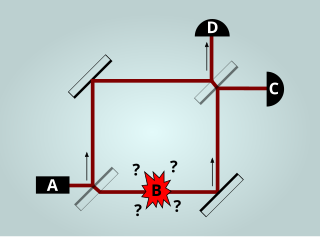
The many-worlds interpretation (MWI) is a philosophical position about how the mathematics used in quantum mechanics relates to physical reality. It asserts that the universal wavefunction is objectively real, and that there is no wave function collapse. This implies that all possible outcomes of quantum measurements are physically realized in some "world" or universe. In contrast to some other interpretations, the evolution of reality as a whole in MWI is rigidly deterministic and local. Many-worlds is also called the relative state formulation or the Everett interpretation, after physicist Hugh Everett, who first proposed it in 1957. Bryce DeWitt popularized the formulation and named it many-worlds in the 1970s.
The mathematical formulations of quantum mechanics are those mathematical formalisms that permit a rigorous description of quantum mechanics. This mathematical formalism uses mainly a part of functional analysis, especially Hilbert spaces, which are a kind of linear space. Such are distinguished from mathematical formalisms for physics theories developed prior to the early 1900s by the use of abstract mathematical structures, such as infinite-dimensional Hilbert spaces, and operators on these spaces. In brief, values of physical observables such as energy and momentum were no longer considered as values of functions on phase space, but as eigenvalues; more precisely as spectral values of linear operators in Hilbert space.

Quantum mechanics is a fundamental theory in physics that describes the behavior of nature at and below the scale of atoms. It is the foundation of all quantum physics including quantum chemistry, quantum field theory, quantum technology, and quantum information science.

In quantum mechanics, Schrödinger's cat is a thought experiment, sometimes described as a paradox, of quantum superposition. In the thought experiment, a hypothetical cat may be considered simultaneously both alive and dead, while it is unobserved in a closed box, as a result of its fate being linked to a random subatomic event that may or may not occur. This thought experiment was devised by physicist Erwin Schrödinger in 1935 in a discussion with Albert Einstein to illustrate what Schrödinger saw as the problems of the Copenhagen interpretation of quantum mechanics.
Quantum suicide is a thought experiment in quantum mechanics and the philosophy of physics. Purportedly, it can falsify any interpretation of quantum mechanics other than the Everett many-worlds interpretation by means of a variation of the Schrödinger's cat thought experiment, from the cat's point of view. Quantum immortality refers to the subjective experience of surviving quantum suicide. This concept is sometimes conjectured to be applicable to real-world causes of death as well.
The de Broglie–Bohm theory, also known as the pilot wave theory, Bohmian mechanics, Bohm's interpretation, and the causal interpretation, is an interpretation of quantum mechanics. It postulates that in addition to the wavefunction, an actual configuration of particles exists, even when unobserved. The evolution over time of the configuration of all particles is defined by a guiding equation. The evolution of the wave function over time is given by the Schrödinger equation. The theory is named after Louis de Broglie (1892–1987) and David Bohm (1917–1992).
An interpretation of quantum mechanics is an attempt to explain how the mathematical theory of quantum mechanics might correspond to experienced reality. Although quantum mechanics has held up to rigorous and extremely precise tests in an extraordinarily broad range of experiments, there exist a number of contending schools of thought over their interpretation. These views on interpretation differ on such fundamental questions as whether quantum mechanics is deterministic or stochastic, local or non-local, which elements of quantum mechanics can be considered real, and what the nature of measurement is, among other matters.
In quantum mechanics, a density matrix is a matrix that describes the quantum state of a physical system. It allows for the calculation of the probabilities of the outcomes of any measurement performed upon this system, using the Born rule. It is a generalization of the more usual state vectors or wavefunctions: while those can only represent pure states, density matrices can also represent mixed states. Mixed states arise in quantum mechanics in two different situations:
- when the preparation of the system is not fully known, and thus one must deal with a statistical ensemble of possible preparations, and
- when one wants to describe a physical system that is entangled with another, without describing their combined state; this case is typical for a system interacting with some environment.
Wigner's friend is a thought experiment in theoretical quantum physics, first published by the Hungarian-American physicist Eugene Wigner in 1961, and further developed by David Deutsch in 1985. The scenario involves an indirect observation of a quantum measurement: An observer observes another observer who performs a quantum measurement on a physical system. The two observers then formulate a statement about the physical system's state after the measurement according to the laws of quantum theory. In the "orthodox" Copenhagen interpretation, the resulting statements of the two observers contradict each other. This reflects a seeming incompatibility of two laws in the Copenhagen interpretation: the deterministic and continuous time evolution of the state of a closed system and the nondeterministic, discontinuous collapse of the state of a system upon measurement. Wigner's friend is therefore directly linked to the measurement problem in quantum mechanics with its famous Schrödinger's cat paradox.
In quantum mechanics, wave function collapse occurs when a wave function—initially in a superposition of several eigenstates—reduces to a single eigenstate due to interaction with the external world. This interaction is called an observation, and is the essence of a measurement in quantum mechanics, which connects the wave function with classical observables such as position and momentum. Collapse is one of the two processes by which quantum systems evolve in time; the other is the continuous evolution governed by the Schrödinger equation. Collapse is a black box for a thermodynamically irreversible interaction with a classical environment.

In quantum mechanics, a probability amplitude is a complex number used for describing the behaviour of systems. The square of the modulus of this quantity represents a probability density.
In quantum mechanics, the measurement problem is the problem of how, or whether, wave function collapse occurs. The inability to observe such a collapse directly has given rise to different interpretations of quantum mechanics and poses a key set of questions that each interpretation must answer.

The Elitzur–Vaidman bomb-tester is a quantum mechanics thought experiment that uses interaction-free measurements to verify that a bomb is functional without having to detonate it. It was conceived in 1993 by Avshalom Elitzur and Lev Vaidman. Since their publication, real-world experiments have confirmed that their theoretical method works as predicted.

Wheeler's delayed-choice experiment describes a family of thought experiments in quantum physics proposed by John Archibald Wheeler, with the most prominent among them appearing in 1978 and 1984. These experiments are attempts to decide whether light somehow "senses" the experimental apparatus in the double-slit experiment it travels through, adjusting its behavior to fit by assuming an appropriate determinate state, or whether light remains in an indeterminate state, exhibiting both wave-like and particle-like behavior until measured.
The Penrose interpretation is a speculation by Roger Penrose about the relationship between quantum mechanics and general relativity. Penrose proposes that a quantum state remains in superposition until the difference of space-time curvature attains a significant level.
The universal wavefunction or the wavefunction of the universe is the wavefunction or quantum state of the entire universe. It is regarded as the basic physical entity in the many-worlds interpretation of quantum mechanics, and finds applications in quantum cosmology. It evolves deterministically according to a wave equation.
Relational quantum mechanics (RQM) is an interpretation of quantum mechanics which treats the state of a quantum system as being relational, that is, the state is the relation between the observer and the system. This interpretation was first delineated by Carlo Rovelli in a 1994 preprint, and has since been expanded upon by a number of theorists. It is inspired by the key idea behind special relativity, that the details of an observation depend on the reference frame of the observer, and uses some ideas from Wheeler on quantum information.
In physics, the observer effect is the disturbance of an observed system by the act of observation. This is often the result of utilizing instruments that, by necessity, alter the state of what they measure in some manner. A common example is checking the pressure in an automobile tire, which causes some of the air to escape, thereby changing the pressure to observe it. Similarly, seeing non-luminous objects requires light hitting the object to cause it to reflect that light. While the effects of observation are often negligible, the object still experiences a change. This effect can be found in many domains of physics, but can usually be reduced to insignificance by using different instruments or observation techniques.
This is a glossary for the terminology applied in the foundations of quantum mechanics and quantum metaphysics, collectively called quantum philosophy, a subfield of philosophy of physics.
The von Neumann–Wigner interpretation, also described as "consciousness causes collapse", is an interpretation of quantum mechanics in which consciousness is postulated to be necessary for the completion of the process of quantum measurement.






